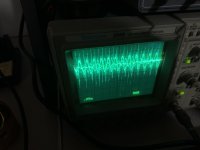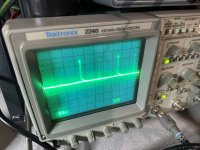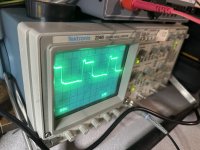Why is it in protect?
That's the emitter of the driver. I need to see the base.
The first scope settings are much better.
The the output on most class D amps, 0.2v/div is picking up noise and is mostly useless.
That's the emitter of the driver. I need to see the base.
The first scope settings are much better.
The the output on most class D amps, 0.2v/div is picking up noise and is mostly useless.
0.2v/div is useless for most all class D amps.
Look up the datasheet if you don't know the pin configuration of any component. For most small transistors with an A, B, C or D prefix, the pin configuration is ECB. Look up the datasheet to confirm the configuration.
Do you have any 1k resistors?
Look up the datasheet if you don't know the pin configuration of any component. For most small transistors with an A, B, C or D prefix, the pin configuration is ECB. Look up the datasheet to confirm the configuration.
Do you have any 1k resistors?
Previously, the duty cycle was near 50%. Now it's very low. The difference may be that the amp was having trouble starting when your scope was causing problems.
Did you mean 'on' as in the scope was powered up or 'on' as in having your probe connected to the amp?
Reduce the 12v supply voltage. Can you force the amp to full duty cycle before it shuts down?
Leave the supply providing the remote voltage at the same voltage as it is now.
Did you mean 'on' as in the scope was powered up or 'on' as in having your probe connected to the amp?
Reduce the 12v supply voltage. Can you force the amp to full duty cycle before it shuts down?
Leave the supply providing the remote voltage at the same voltage as it is now.
On as in scope powered up
I’m not sure how I would do that
I have my 40amp power supply powering it right now at 13.5v.
I have a second supply which I had shown previously.
I can hook both of them up, supply remote with 13.5v with the lower power supply, and lower my 40a supply to 12v, is this what you mean?
I cannot use the original supply for power as it is 3a max and the amp will not power on with that
I’m not sure how I would do that
I have my 40amp power supply powering it right now at 13.5v.
I have a second supply which I had shown previously.
I can hook both of them up, supply remote with 13.5v with the lower power supply, and lower my 40a supply to 12v, is this what you mean?
I cannot use the original supply for power as it is 3a max and the amp will not power on with that
Do whatever you have to do with whatever you have to keep the remote voltage steady and lower the voltage feeding the main B+ and ground. You may have to go lower than 12v. Go as low as you can until you get back to 50% duty cycle.
I will most likely use the 2 power supplies. If I do will I need to connect both to the amplifier ground/negative connection?
If you lower the B+ supply, does the pulse width increase?
Does the idle current increase as you get down to approximately 10.5v?
Does the idle current increase as you get down to approximately 10.5v?
The supply feeding the large terminal is what you want to reduce. Not remote. We are using two supplies because low remote voltage was causing problems with this amp.
No, but it still goes into protect when any sort of signal is passed. Swapped RCA plate from parts amp and same result.
I am using my phone with an aux to RCA cable adapter as a tone generator. I have a spare headunit I can use to see if it still goes into protect, do you think that would cause any change?
I am using my phone with an aux to RCA cable adapter as a tone generator. I have a spare headunit I can use to see if it still goes into protect, do you think that would cause any change?
By having the ground of the head unit connected to the PS that's powering the amplifier, the RCA shields should read 0 ohms to the PS ground with no other connections.
- Home
- General Interest
- Car Audio
- 2 Monoblock Class Ds Not Working, I'm Lost



